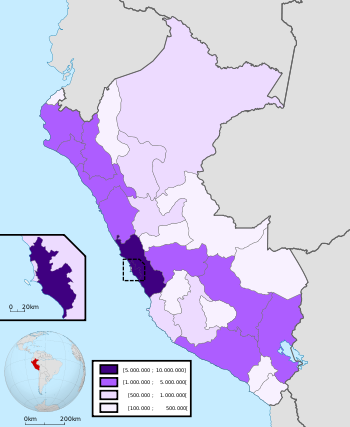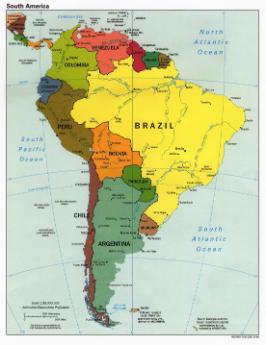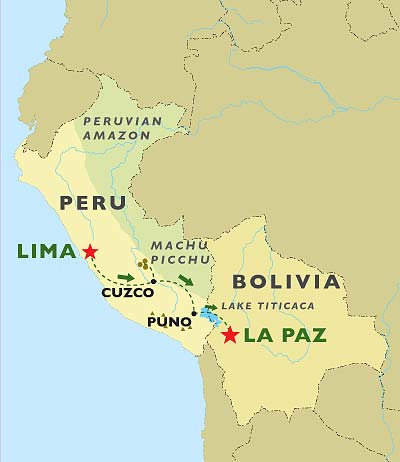Peru is a country in South America, bordered by Ecuador, Colombia, Brazil, Bolivia and Chile. The territory of Peru was home to the ancient Inca Empire, was conquered by the Spanish Empire in the 16th century and achieved independence in 1821.
History of PeruThe concept of territoriality is very interesting. It is how people or government communicates how much space or land they need non-verbally. Such as the Ecuadorian-Peruvian War, which went on for 170 years and was the longest running international conflict in the Western Hemisphere. The dispute was the aftermath of imprecise geographical definitions set in colonial times to define the limits of the Royal Audiences.
Politics & GovernmentPolitical boundaries serve a great purpose. They influence how our goods and services are distributed, who is represented or not and how many of the national issues are presented and dealt with. Political boundaries are not something decided by the rivers in place or the mountains in that particular area, no, political boundaries are decided upon by the government. Sometimes those lines are blurred by disputes between countries and nations that share a boundary, such as the Ecuadorian-Peruvian dispute. Those political boundaries had become an issue to be dealt with by the 19th Century, and was fought over for the next 150 years.
Changing the nature of sovereignty is quite complicated. The definition of a sovereign state is 'A state which administers its own government, and is not dependent upon, or subject to, another power.' Which makes it difficult because that leads up to the question, is a country under imperialism by another nation still a sovereign state? Yes, in a way. It can retain its sovereignty by Neocolonialism, which is a system put in place usually by imperialistic countries over developing sovereign states. The imperialistic nations take control of the economic, scientific and technological powers of the country while still having it hold the position of a sovereign state. A good example of neocolonialism is imperialist powers directing the possibility of maintaining capitalism and preventing the spread of socialism in developing areas such as Asia, Africa and Latin America.
By 1968 Peru had several successful authoritarian and democratic governments and leaders. However, by 1968, a military general named Juan Alvarado staged a coup that would lead to having a leftist government until 1975. A new president was installed then, and allowed elections to be held and counted freely by 1980. However, a group called Rise of Shining Path was against the Peruvian state and started several street fights and minor conflicts. In 1980, when people were allowed to freely vote, Rise of Shining Path declined and resorted to guerrilla war instead. The night of the election they went from town to town to burn ballot boxes. These were known as the first attacks of terror upon the state of Peru. Gradually Rise of Shining Path commit more and more crimes against the National Police of Peru and in 1981 Fernando Terry declared a state of emergency and sent armed forces against the Rise of Shining Path.
Peru is a unitary state government, as the majority of the world's nations. In a unitary state, subnationals units, states or provinces, are created and can be broadened or narrowed by the central government. There are also powers only the federal government can control, however delegating enough freedom to local government by statutes and laws, the central government remains in power.
Peru is a representative democratic republic with 25 equal regions and the province of Lima. It is a multi-party system, and the two main parties are National Unity and the Peruvian Nationalist Party. National Unity is right-wing, conservative and Christian party founded in 2000. The Peruvian Nationalist Party is far left wing, and holds the current president of Peru, Ollanta Humala. The Nationalist party holds itself to four central pillars on its political platform; Anti-Imperialism, Democratic Republicanism, Andean Amazonic Republicanism, and Latinamericanism.
Colonialism vs. ImperialismColonialism and Imperialism are often used interchangeably but they are in fact two very different things. Colonialism is when a country completely conquers a new nation and controls it. Imperialism is when a country takes control of the political or economic powers in another nation. Basically said, colonialism is claiming sovereignty over a nation and imperialism is, as defined by the People of Human Geography, the creation and/or maintenance of an unequal economy or relationship between countries. Peru's current President, Ollanta Humala, is strongly Anti-Imperialism.
|
|
Above is a map of Peru and Bolivia, and you can see how they would have been allies as they share borders and there is an easy route in between both countries that would have worked very well with trading.
Peru & BoliviaPeru and Bolivia used to be unified allies, once forming a short lived confederation between each other, making them a unified South American State. The confederation collapsed after losing a war between the combined Chilean and Peruvian dissident now known as the War of Confederations. More recently, the President of Bolivia visited Peru and was in contact with Ollanta Humala, who would like to form a unification with Bolivia once again.
Push & Pull FactorsThere are several push and pull factors of Peru. If you are speaking of living in Lima, the pull factors are; Great food, cheap rate of living, lots of nightlife, beautiful scenery, surfing and beachwalking most of the year, and as Lima is in relatively central Peru, you can travel fairly quickly to other cities and countries. Some of the push factors of living in Peru is of course, the density. Peru is what people consider an overpopulated country. People will come from living in the mountains to the cities and that is why there are so many homeless and sheltered people in largely dense parts of Peru such as Lima and Arequipa. There is horrid traffic in the cities, and if you are white the infamous con artists of South America will more than likely come and try to steal from you.

Pictured above is a map of Peru, with the color going darker where the population is larger. As you can see, the dark purple region is where the capitol is, Lima, and it is much more populated than say the large lightly colored purple region of Loreto or some of the white colored places such as Madre de Dios and Ucayali. As well, as the map shows, the smaller regions are more densely populated, and that has to do with how they are much more urban than the rural lightly colored areas.
Foreign Policies of Peru Emigration and immigration to and from Peru starts in 1775, when the Spanish immigrate there from the regions of Castilla and Extremadura. Later in the 19th and early 20th century people from Japan migrated to Peru after World War II. Most people who emigrated from Europe came from Germany, England and Italy.
Peru's foreign relations have been fairly good in the recent years. They have been a member of the UN since 1949, and Peru is planning a full move into AFTA, Andean Free Trade Agreement. AFTA is, in overview, a line of attempts trying to open up the free trade markets for corporate expansion in Latin America. However, the relationship between the United States and Peru has been strained because of the tainted re-election of the former president. That changed in 2001 with a new president, Alejandro Toledo, and a fair and free election.
When the world started separating into states which bore political boundaries, things started getting complicated. The land was to be divided, each nation needed a government of some sort to function, and who's fault was it if the environmental resources we all depend on dearly started depleting? The ozone layer, the loss of biodiversity and global warming are all huge factors in the environmental argument between continents and nations. We can all agree the more urban areas had a more influential role to play, and with more and more urbanization to come, how are we going to divide up the resources needed to fix the problems we ourselves caused?
|


